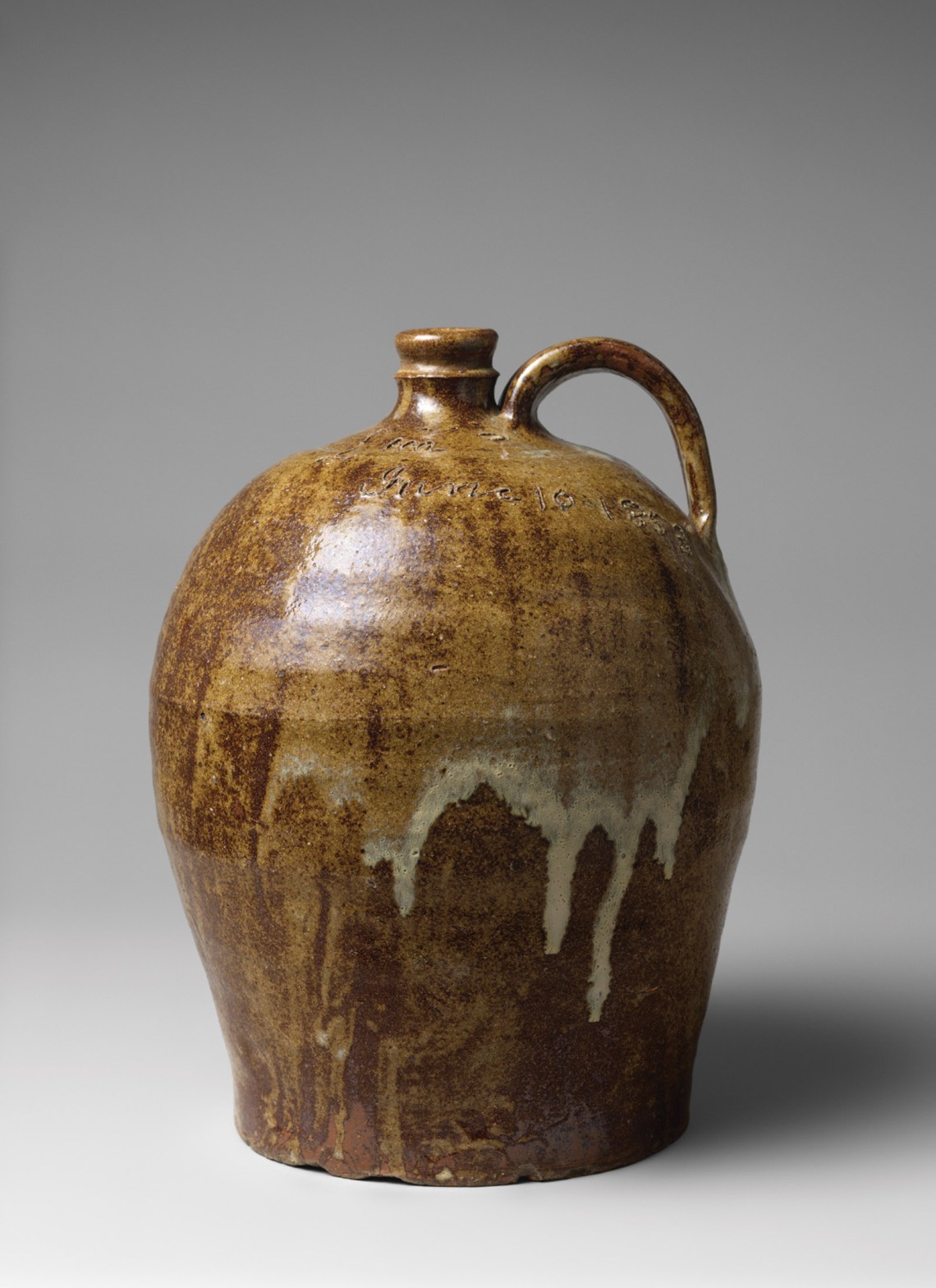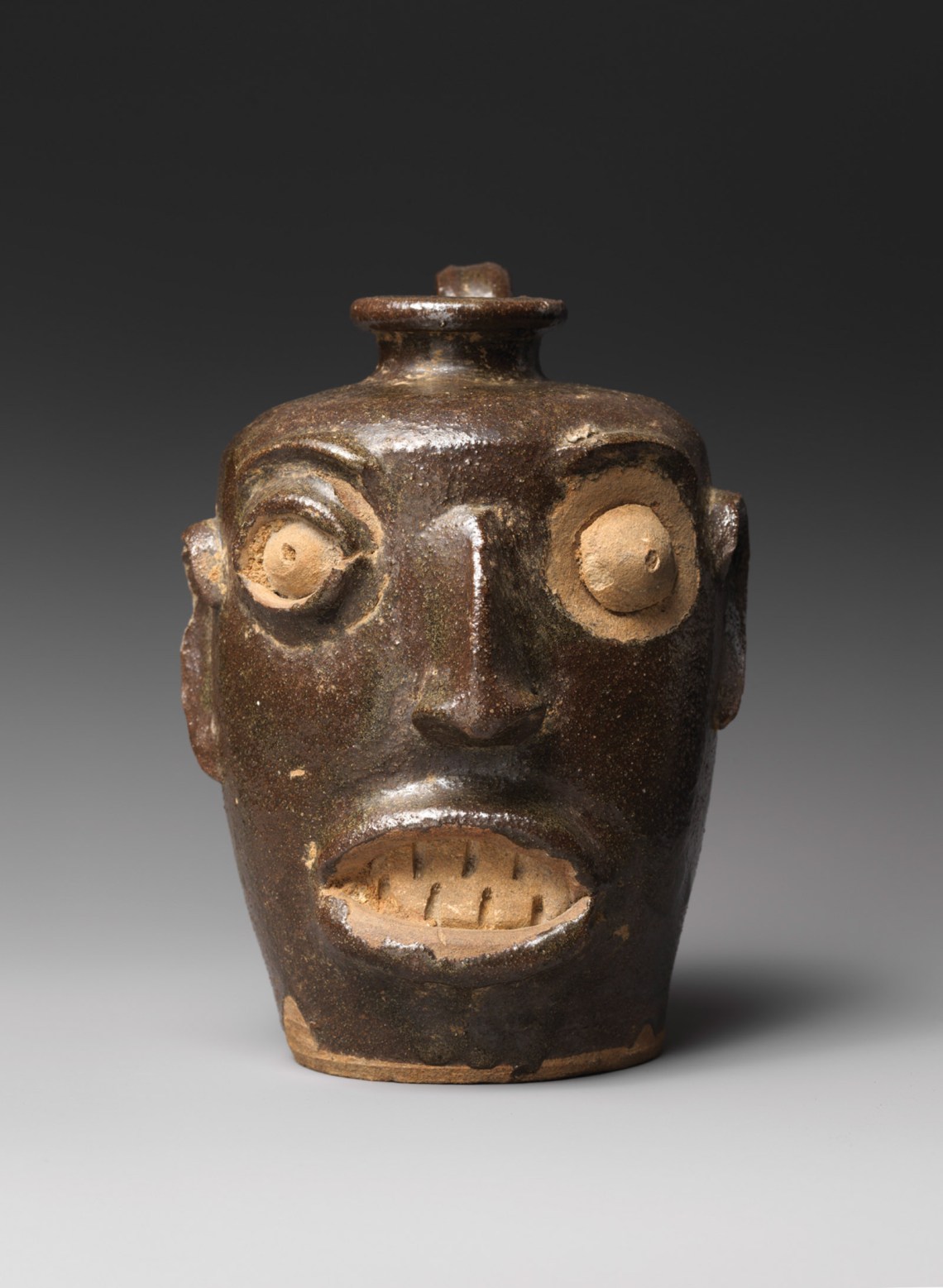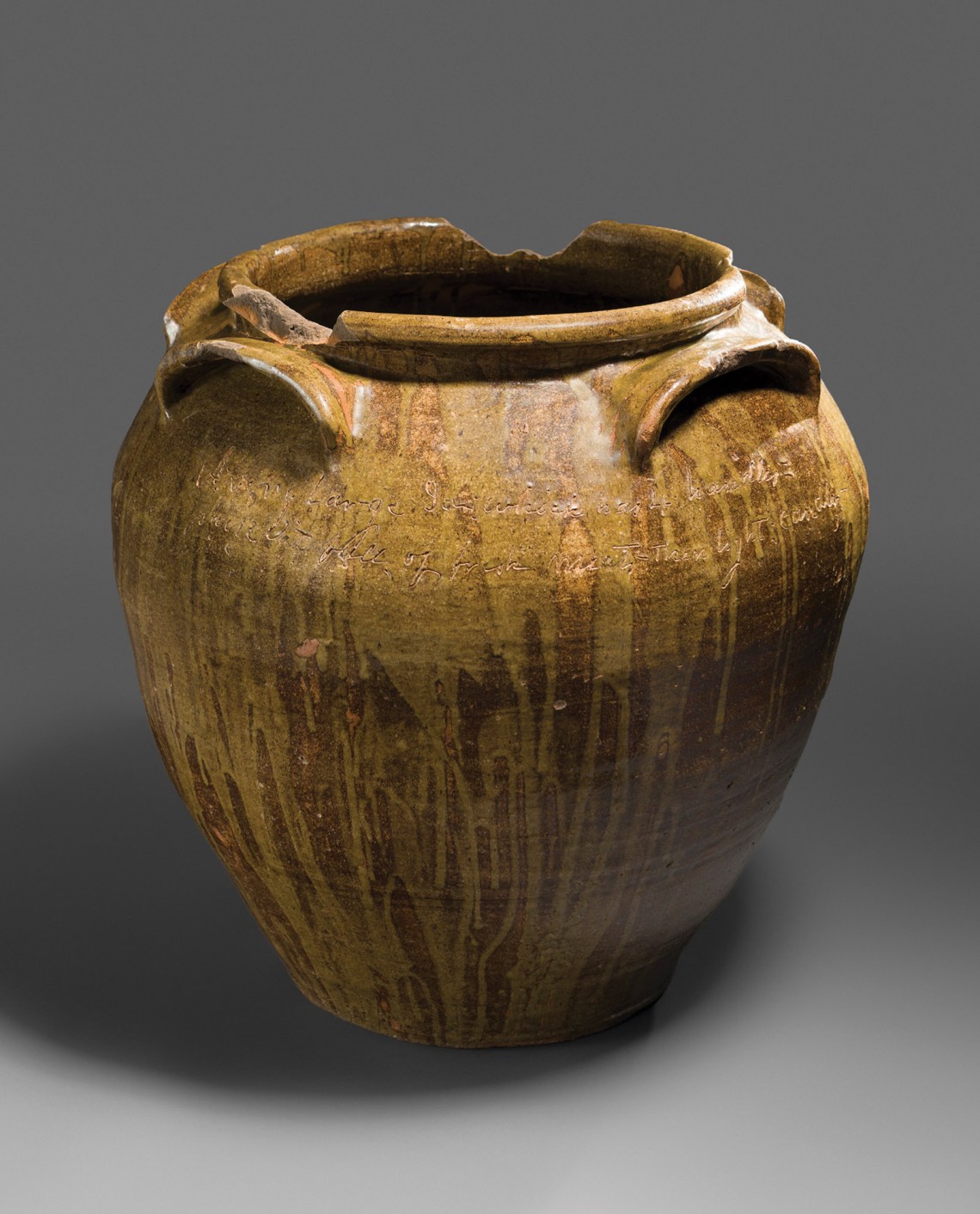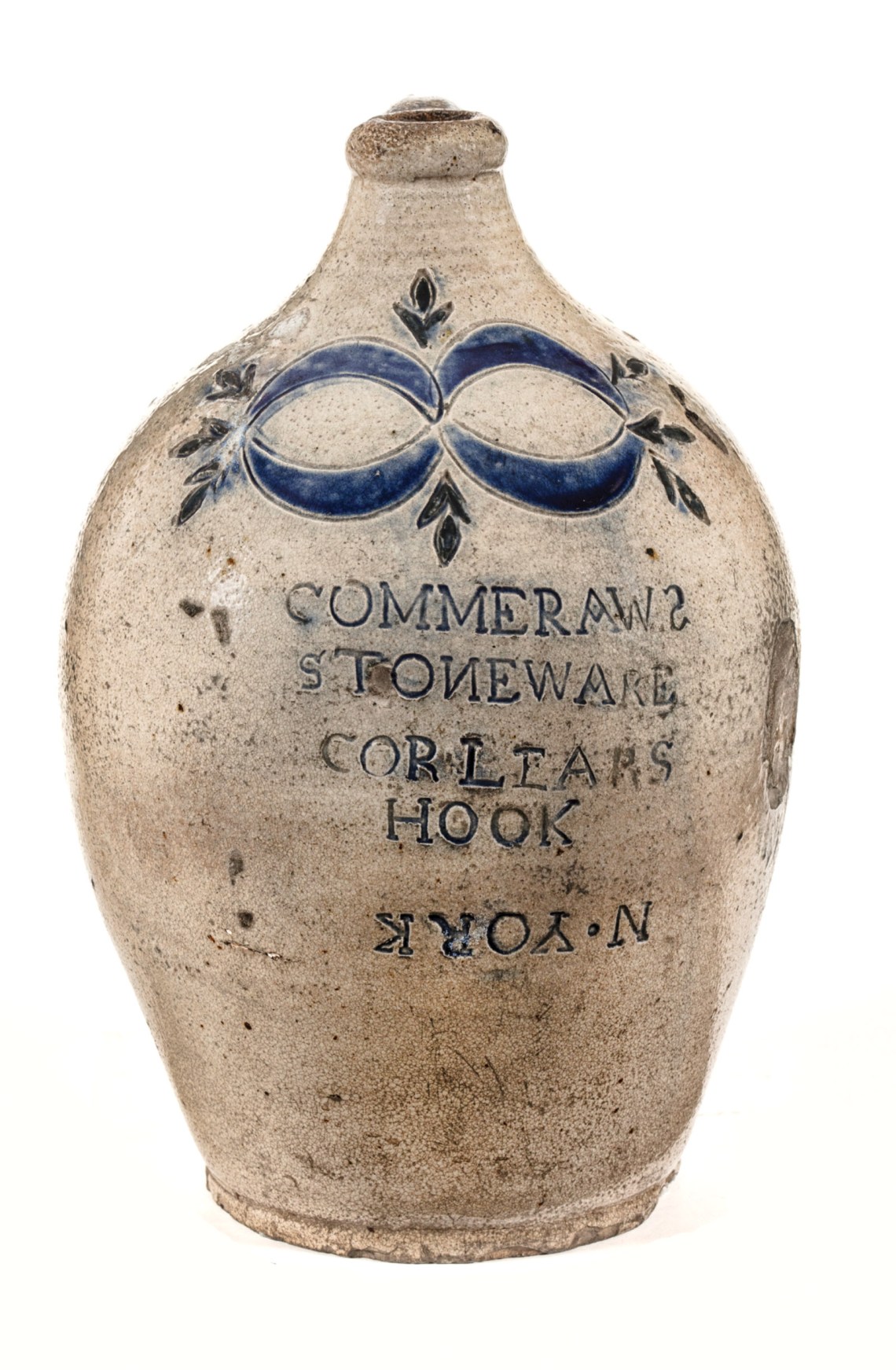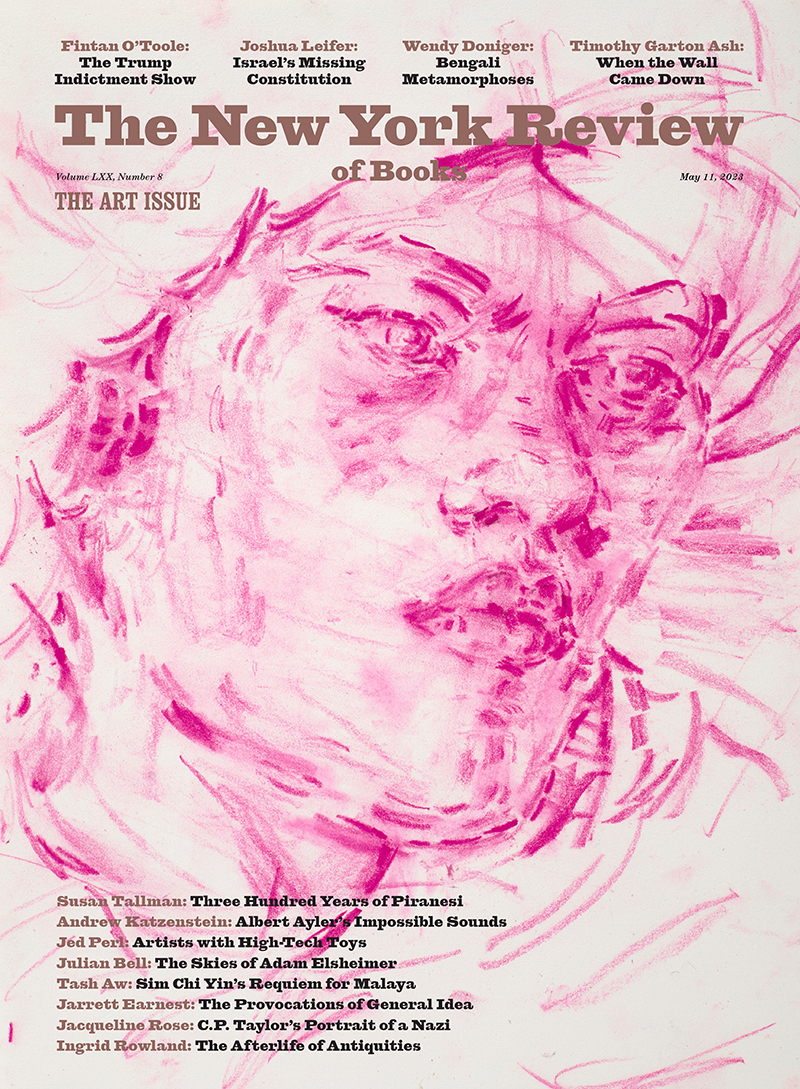Beautiful pots have been fashioned for centuries by American makers, whether indigenous, enslaved, or of European origin. But their status in the hierarchy of museum objects has remained precarious. Asian pots are often accorded a reverent, hush-hush setting, and have inspired a centuries-old tradition of connoisseurship, commentary, and ritual: certain raku tea bowls, in particular, are designated National Treasures by the Japanese government, given honorific names, and celebrated in poetic tributes. American pots, by contrast, are often left to speak for themselves.1 In the anodyne world of American craft, political engagement (with rare exceptions such as Judy Chicago’s porcelain in The Dinner Party, a tribute to feminist icons) is largely inaudible. But two recent exhibitions, on either side of Central Park, find acts of resistance in the placid history of nineteenth-century American stoneware.
New England stoneware jugs, with their pearly salt glaze decorated with blue cobalt, have long been found among the clutter of our historic houses. Lead-free and watertight, such stoneware vessels were fired at a higher temperature than porous earthenware, lower than vitrified porcelain. Their southern cousins, the big-bellied whiskey jugs, preside on porches in Georgia and the Carolinas. It was just such a vessel that Wallace Stevens celebrated in “Anecdote of the Jar.” With its plainspoken aesthetic in both word and clay (“I placed a jar in Tennessee,/And round it was, upon a hill”), the poem has been interpreted by Helen Vendler as an American answer—rough-hewn and trailing no history—to the classical trappings of Keats’s “Ode on a Grecian Urn.” The urn speaks of the unity of Truth and Beauty; the jar is mute.
No figure in the great American stoneware tradition has received more attention in recent years than the master artisan who signed his name “Dave” and was active in South Carolina from the 1830s until his death sometime during the 1870s. As with most enslaved people, few details are known with certainty about the man sometimes given a mild honorific and called “Dave the Potter.” What we do know is that his majestic pots were made in a world of forced labor and capricious violence. Visitors to the Metropolitan Museum had the opportunity, for a few months this fall and winter, to linger in the presence of a dozen of these profoundly moving works in the exhibition “Hear Me Now” (currently on view at the Museum of Fine Arts in Boston).
Dave’s pots speak to us with a double voice, first by their commanding presence—they take “dominion everywhere,” as Stevens wrote of his Tennessee jar—and second by the suggestive inscriptions etched on their shoulders. Not only did Dave flaunt his literacy, which was strictly prohibited among enslaved people by South Carolina law; he also embedded messages of protest and lament in rhymed couplets like this one, written in 1857, after his wife and children were sold to a distant slaveholder:
I wonder where is all my relation
Friendship to all—and every nation.
Born around 1801, Dave (who called himself David Drake after emancipation, adopting the surname of one of his owners) spent his life in a clay-rich region in western South Carolina known as Old Edgefield. Slavery is usually thought of as an agricultural institution, but in Edgefield enslaved potters worked in large-scale industrial enterprises producing pots for everyday use. The big pots signed “Dave” are storage jars for the preservation of meat. Too big to be thrown (or, as southerners say, “turned”) entirely on the wheel, they were formed, like comparable Japanese pots from Shigaraki or Tamba, by adding clay coils to a thrown base to achieve the desired height. Such pots were manufactured in large quantities; a nineteenth-century wood-fired kiln recently excavated in Edgefield is over a hundred feet long.
Enslaved Edgefield potters made another kind of pot, smaller and evidently for private use. These highly expressive works, an array of which were on view at the Met (along with contemporary responses by artists including Simone Leigh and Adebunmi Gbadebo), have distorted faces with exaggerated features and white eyes. The eyes and teeth are made with kaolin, the chalk-white clay used in porcelain production. Theories differ about the origin of these “face vessels,” which for many years, as the Met curator Adrienne Spinozzi explains in a fascinating essay, were accorded a racist interpretation as “monkey jugs.” In some respects, they resemble the eighteenth-century English drinking mugs known as Toby Jugs. The art historian Robert Farris Thompson identified analogies with African traditions of funerary art, where ghostly kaolin was believed to open a conduit to the dead. Thompson adopted the term “Afro-Carolinian” to indicate the hybrid origins of the face vessels. As with many distinctively American things—the blues, jazz, modern dance—it is likely that there was no single place or evolutionary line of origin.
Advertisement
Dave is not known to have made face vessels, but his “poem-jars” also seem to draw on multiple sources. His first known inscription, dated 1834, is the single word “Concatination.” Did someone say in his hearing that the word derived from the Latin catena (chain)?2 Later he adopted the rhymed epigram, in the style of Alexander Pope, as his preferred poetic form. He drew his themes from the Bible, from daily life, and from the look and function of his “noble jars,” as he called them. We know nothing about his writing process, whether secretive or collaborative, or his intended audience. Did his owners encourage his inscriptions or deplore them? Since he dated his work, we know that his surviving inscriptions come from two distinct periods when he was owned by a potter named Lewis Miles. “Lm says this handle will crack,” Dave inscribed a jug in 1854 in large letters. Lm turned out to be wrong.
Dominating the Met’s installation was a two-foot-tall pot with a capacity of twenty-five gallons, signed and dated April 12, 1858 (see illustration below). Inscribed on its shoulder, in cursive, is its description and use:
A very Large Jar which has 4 handles =
pack it full of fresh meats—then light candles—
A layer of melted wax protected the contents from spoilage, though the lit candles also suggest a celebratory meal. The rim of the thick-walled pot is chipped in three places, giving it a weathered, archaic look. The juicy, greenish-gray alkaline glaze dripping down the sides resembles certain works from Japan. In fact, the glaze was discovered by an Edgefield potter named Abner Landrum, who was trying to match the milky-white Chinese celadon of fine porcelain and stumbled on this earthier recipe instead.
The four-handled pot is in the collection of the deep-pocketed Crystal Bridges Museum of American Art, which purchased it at auction in 2021 for $1.56 million. With four museums reportedly bidding, this was the highest price ever paid for a work of American ceramics. It might seem that a victory has been won in such transactions, and that a major artist has been recognized after decades on the margins. Aesthetic value is not the same thing as market value, however, and none of Dave’s descendants is getting a cut of the proceeds. Dave wrote on a pot in 1857:
I made this Jar for cash—
though its called = lucre Trash
Money was made from his labor then and is being made from his labor today.
Meanwhile, a debate is emerging concerning the proper display and interpretation of these pots. It has been felt that the white walls of the museum, highlighting the purely aesthetic aspects of the pots, are merely a further limitation—an interpretive confinement—of what the works represent. It would seem that there is a third kind of value, neither market nor aesthetic, a value we might call cultural. “How can we best admire the skill, imagination, and even devotion that went into the making of these vessels when they were the direct product of a bloody system of oppression?” asks the Harvard historian Vincent Brown in an essay for the show’s catalog.3
In a world of coercion and violence, the curators argue, Dave should be seen as a resistance fighter. Contributors to the catalog seek “hidden transcripts of resistance” in Dave’s epigrams. “Dave belongs to Mr. Miles,” Dave wrote in 1840, “whir the oven bakes & the pot biles.” “Did the pot boil,” Brown wonders, “or contain bile,” arising from “the bitterness of Dave’s separation from his loved ones?” Did the inscription “not counted” on an unusually large pot refer to the vessel’s volume or, as Michael J. Bramwell and Ethan W. Lasser suggest, did it “reflect the pot’s experimental character” within a regimented system “that stymied innovation and experimentation”? Such interpretations may seem unduly speculative, even wishful. But if you close your ears to double meanings, you will never hear them.
The curators suggest that Dave’s literacy may be a clue to his missing leg, long assumed, on the basis of a 1930 interview with a man who claimed to remember him, to have resulted from a drunken episode when Dave fell asleep on railroad tracks. Might Dave’s disability have resulted instead from retribution for his writing? “At a time when amputations were standard forms of punishment for offenses like reading, writing, and self-liberating,” write Bramwell and Lasser, “it seems plausible that Dave’s missing limb was not the result of a steam-train accident.”
Advertisement
The suggestion has fomented a minor controversy. A statement drafted by Leonard Todd, the author of a biography of Dave, and signed by a group of scholars and potters, has challenged the Met’s claim that evidence for corporal punishment is more “plausible” than the evidence for the accident on the railroad tracks. As a direct descendant of one of Dave’s owners, Todd is perhaps not the ideal spokesman for such a position. It should be said that the evidence for the accident is itself a little shaky. The wording of the 1930 interview is equivocal: “They say he got drunk and layed on the railroad track.” There are many ways to lose a limb in an industrial setting. (My own grandfather, a North Carolina brickmason, had a missing index finger, and my mother was never quite sure how he lost it.) The interview is also the principal record of Dave’s missing leg. If the accident is in question, maybe the missing leg should be, too.
It may well be that the celebration of Dave as a resistance fighter is a necessary stage in the interpretation of his work and its incorporation into a larger cultural history of the United States. In a similar development, every departure in Emily Dickinson’s work from the norms of “patriarchal” publishing—her wayward spelling, her innovative punctuation, her methods of self-publication via letter or hand-sewn booklet—has been seen as a gesture of resistance.4 Resistance takes many forms, and these artists worked bravely against the grain of their times. “Noble,” one of Dave’s favorite words, seems an appropriate adjective for his astonishing achievement.
A more straightforward case for a potter engaged in acts of resistance can be made for the New York–based master artisan Thomas Commeraw, the subject of a revelatory exhibition at the New-York Historical Society. I first encountered Commeraw’s work in a previous show at the same venue devoted to folk art collected by the modernist sculptor Elie Nadelman. For nearly a century, among sophisticated collectors like Nadelman, Commeraw’s elegant work was grouped with that of other stoneware producers based in Lower Manhattan, with stylistic links to work by the Crolius family, German immigrants who brought to the city the European tradition of salt-glazed stoneware decorated with blue cobalt. Only in 2003 did the scholar A. Brandt Zipp discover that Commeraw was listed as black in official records.
To be surrounded by Commeraw’s work is a very different experience than being in the company of Dave’s monumental jars. The pots are much smaller and aimed at an urban audience familiar with the scrolls and serifs of neoclassical artistic conventions. Refined in a conventional sense, even genteel, they feel like indoor pots, designed to be appreciated up close. One striking example boasts a gently swelling ovoid form, a glassy off-white glaze, a ring of blue tassels and bows, and Commeraw’s incised name and locale circling a deftly executed spout and handle. Like Dave’s big pots, though on a lesser scale, Commeraw’s work has risen dramatically in value. The pot with the ring of blue tassels recently sold at auction for $96,000.
Research following Zipp’s surprising discovery has revealed that the potter William Crolius, an American patriot during the Revolution, had owned Commeraw’s family members and freed them (perhaps in response to the revolutionary fervor of the time) in his 1778 will, when Thomas was around seven years old. We know nothing of Commeraw’s training, either under slavery or as an apprentice after his manumission, or the steps by which he established his own independent practice. What we do know is that he was apparently the sole black owner of a pottery firm and that he managed—through the sheer quality of his work as well as his strategic use of flamboyant decoration and astute branding—to compete against his established white rivals.
We also know that he was active in antislavery causes in New York. He led efforts to assist manumitted African Americans and “to free others of their brethren from bondage.” He campaigned for voting rights for black men at a time when they were increasingly subjected to identity and property tests, among other methods of voter suppression. He composed a hymn for the second anniversary of the abolition of the transatlantic slave trade and conducted music performances at New York’s first black church.
When his flourishing business was imperiled amid the financial downturn after the War of 1812, Commeraw took the extraordinary step in 1820 of joining the first group of settlers in Sierra Leone, an attempt by the white-led (and, as became increasingly clear, white supremacist) American Colonization Society to establish a black republic in the African “homeland.” The poorly planned experiment was an unmitigated disaster. Commeraw’s wife and niece succumbed to malaria; a quarter of the settlers and all the white agents died as well. Commeraw returned to the US a broken man and died in 1823.
Does Commeraw’s work reflect his lifelong commitment to social advocacy? One could argue that the excellence of his work—its exquisitely balanced forms, its luminous salt-glaze surfaces, its refined decoration—was an effort to demonstrate the capacity of African American artisans to master the most exacting trades. Such was among the principal aims of Booker T. Washington’s vocation-based Tuskegee Institute. In his innovative use of stamps, advertising his name and the location of his pottery on Corlears Hook (on the East River, near the present Williamsburg Bridge), Commeraw was, according to the potter-scholar Mark Shapiro (who organized the show with Margi Hofer, the museum director of the New-York Historical Society, and Mellon Postdoctoral Fellow Allison Robinson), “a pioneer in product branding, which he undertook with consistency and verve.” Here we see a personal assertiveness and professional pride on a par with Dave’s marking and signing of his own works.
In another part of his pottery practice, Commeraw made cylindrical pickle jars for local oystermen, a trade dominated by African Americans, and stamped their names and addresses across the jars. In their relative austerity of design, pocked with the ash stains and other surface irregularities of wood-firing, these pickle jars have their own aesthetic integrity, the austerely rustic beauty the Japanese describe with the words wabi and sabi. Here, we feel closer to Dave’s roughhewn majesty.
Other details may display a kindred artistic temperament to Dave’s poetic inscriptions. Commeraw was drawn to mirror images in his work. He adopted the neoclassical taste for so-called swags and tassels in his decorations. But he paired them with their inverted images, resulting in what Shapiro calls his “signature bowknots” or clamshells. Commeraw didn’t stop there, however. He stamped “N. York” upside down on the face of one pot. He started playing with reversed letters as well. He stamped his name “Commeraw.S” with a backward-facing “S.” He labeled his pots “STONEWARE” with a backward “N.” So why did Commeraw do these things? Were they part of a “branding provocation, to make people take note,” as Shapiro suggested to me in an e-mail? Or were they something else?
Idiosyncrasy does not necessarily constitute rebellion. In their insistence on signing their pots with their own names, and doing so with cursive flourishes or attention-grabbing reversals, both Dave and Commeraw claimed proud authorship, if not ownership, of their creations. Both had been enslaved, and the self-possession that ought to reward artistic creation can only go so far when the artist himself is a legal possession, as Dave was during his most productive period. Were the mirror images and double meanings in their work an indication of that “double consciousness” that W.E.B. Du Bois ascribed to all black Americans? Or were they some other kind of provocation, a secret code for insiders, perhaps, or a signal of resistance to societal norms? Dave’s puns and Commeraw’s reversed letters can easily seem so. Now that we are learning to be better attuned to such signals from the past, we will undoubtedly come to recognize more.
-
1
In a clever alignment of Asian and American traditions, the North Carolina potter Mark Hewitt writes of the “Iced Tea Ceremony,” noting that “neither the vessels nor the rituals surrounding the Iced Tea ceremony are as scrutinized and codified as their Japanese counterparts.” Mark Hewitt and Nancy Sweezy, The Potter’s Eye: Art and Tradition in North Carolina Pottery (University of North Carolina Press, 2005), p. 166. ↩
-
2
In his 1828 dictionary Noah Webster defined the verb “concatenate” as “to link together; to unite in a successive series or chain, as things depending on each other.” Though “concatenation” does not appear in Shakespeare, Milton, or the King James Bible, it does appear twice in Samuel Johnson’s life of Alexander Pope. It also appears, suggestively, in Daniel Webster’s famous 1830 speech for the prosecution in the murder of the slave trader Captain White in Salem, Massachusetts. Daniel Webster’s phrase “fearful concatenation of circumstances” made its way into Bartlett’s Familiar Quotations of 1919. ↩
-
3
Many highly regarded Japanese pots were apparently made by enslaved people. It has long been assumed that skilled potters were forcibly removed from Korea to Japan around 1600, after the so-called Imjin War, bringing distinctive Korean ceramic traditions with them. In the Tamba region—where I worked in a family pottery business for a few weeks in 1971, making lids for pickle jars among other tasks—the wheels traditionally turn counterclockwise in the Korean manner, the opposite of most Japanese wheels. ↩
-
4
I compare Dave to Dickinson in my Red Brick, Black Mountain, White Clay (Penguin, 2012), pp. 206–208. ↩

